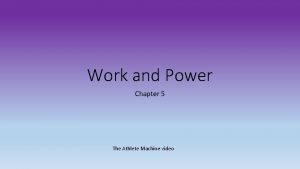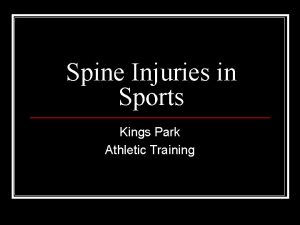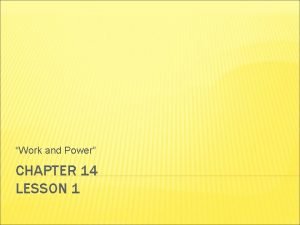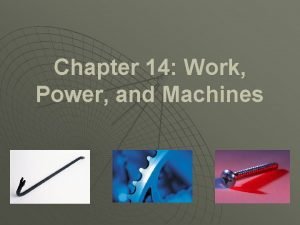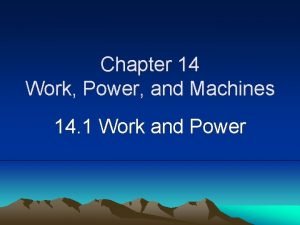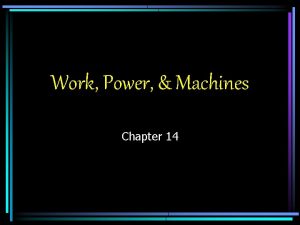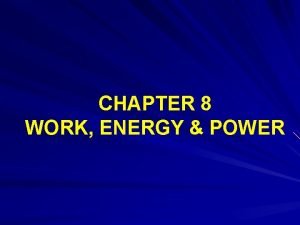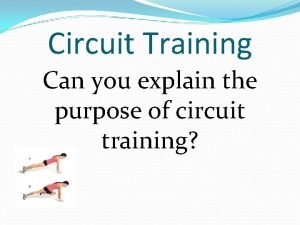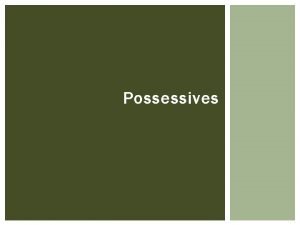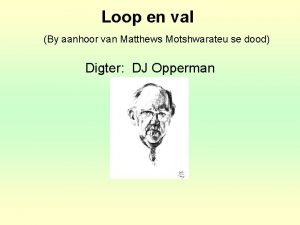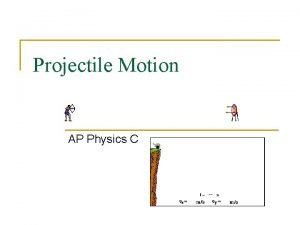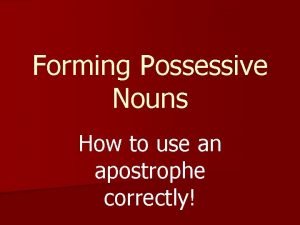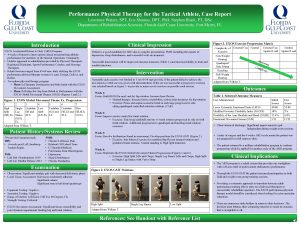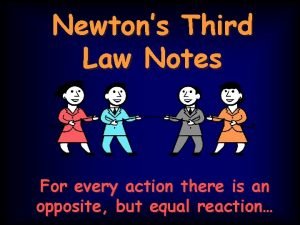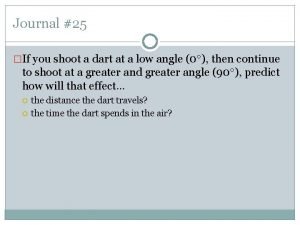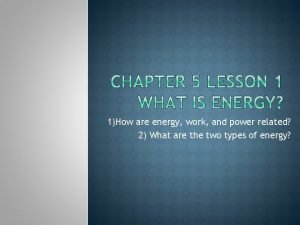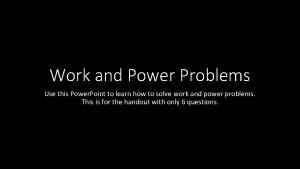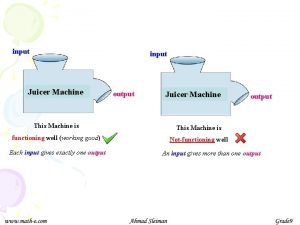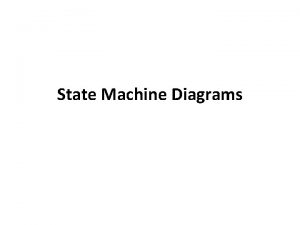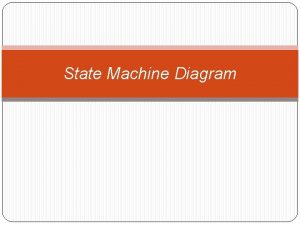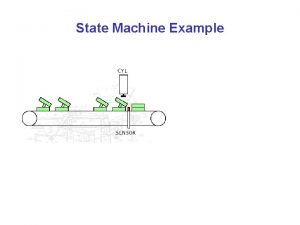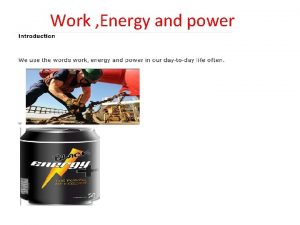Work and Power Chapter 5 The Athlete Machine
























































































- Slides: 88

Work and Power Chapter 5 The Athlete Machine video

Section 5. 1 Notes • In physics, work is done in lifting an object from the floor to the table and in pushing an object across the floor. A force that causes a displacement of an object does work on the object.

• Work is done when a force is exerted on an object causing the object to move in a direction parallel to the component of the applied force. • Work is the product of the magnitudes of the component of a force, • F is along the direction of displacement, • the displacement d • the angle, , between the force and the direction of the displacement. • W = Fdcos

• Work is NOT done when the force is perpendicular to the displacement as cos 90◦ = 0. d • Work is expressed in joules, abbreviated J. • A force of one Newton acting through a distance of one meter does one joule of work. 1 J = 1 Nm • If many constant forces are acting on an object, you can find the net work done by first finding the net force. • Wnet = Fnetd F

• When the force causing the displacement is parallel to the displacement d • cos 0◦ = 1 (for F, d in the same direction) F • cos 180◦ = -1 (for F, d in opposite directions), d • then W = Fd or W = -Fd. F W = Fdcos applies to the work done by one object on another and is the definition of work.

• Work done in lifting an apple from your waist to the top of your head requires about 1 J. Three pushups require about 1000 J. • When the force on an object and the object’s displacement are in different directions, the component of the force that is in the direction of the object’s displacement does work.

Is work done during the following? 1. A student holds a heavy chair at arm’s length for several minutes. 2. A student picks up a pen. 3. A student carries a book horizontally across the room. 4. A student pushes a car across the parking lot.

Ex 1. You push your 1500 N car 5. 0 m with a horizontal force of 35 N. What work have you done?

Ex 1. You push your 1500 N car 5. 0 m with a horizontal force of 35 N. What work have you done? F= 35 N W = Fdcos d = 5 m W = (35)(5) cos 0 W? W = 175 J • Remember – parallel and same direction (d and F)=cos 0◦=1

Ex 2. A 20. 0 kg suitcase is raised 3. 0 m above a platform by a conveyor belt. How much work is done on the suitcase?

Ex 2. A 20. 0 kg suitcase is raised 3. 0 m above a platform by a conveyor belt. How much work is done on the suitcase? F=mg F= (20)(9. 81) N W = Fdcos d = 3 m W = (196)(3) cos 0 W? W = 588 J

Ex. 3. How much work is done on a vacuum cleaner pulled 3. 0 m by a force of 50. 0 N at an angle of 30. 0 above the horizontal?

Ex. 3. How much work is done on a vacuum cleaner pulled 3. 0 m by a force of 50. 0 N at an angle of 30. 0 above the horizontal? F= 50 N W = Fdcos d = 3 m W = (50)(3) cos 30 W? W = 130 J

Negative Work • Sometimes a force acts upon a moving object to hinder displacement. • Examples: a car skidding to a stop or a baseball runner sliding to base. • These forces act in the direction opposite the objects motion in order to slow it down. So these forces do not cause the displacement but rather hinder it. • These situations involve what is known as negative work. • Since the force vector is directly opposite the displacement vector, theta is 180 degrees. (cos 180◦=-1) so a negative value results for the amount of work done upon the object.

Positive or Negative Work • Work is a scalar quantity but can be positive or negative. • Work is positive when the component of force is in the same direction as the displacement. • Work is negative when the force is in the direction opposite the displacement. (ex. friction)

Ex. 4 How much work is done by a frictional force of 12 N on a 68 kg box that is moved 5 m along a horizontal surface?

Ex. 4 How much work is done by a frictional force of 12 N on a 68 kg box that is moved 5 m along a horizontal surface? F= 12 N d = 5 m W? W = Fdcos W = (12)(5) cos 180◦ W = -60 J

Ex. You push a 450 N box for 12 m across the floor using a force of 105 N that is applied at a 25◦ angle above the horizontal. The coefficient of kinetic friction is 0. 18 between the box and the floor. a) How much work is done by the floor on the crate? b) How much work is done by you? c) What is the net work done on the box?

Ex. You push a 450 N box for 12 m across the floor using a force of 105 N that is applied at a 25◦ angle above the horizontal. The coefficient of kinetic friction is 0. 18 between the box and the floor. a) How much work is done by the floor on the crate? b) How much work is done by you? c) What is the net work done on the box? FW= 450 N d = 12 m FA= 105 N μk =0. 18 μk = FK / FN 0. 18 = Fk / 450 FK = 81 N (a) W = FK d cos 180 W = (81)(12) cos 180 W = -972 J (b) W = FA d cos 25○ W = 105 (12)(91) W = 1142 J (c) WNET = -972 + 1142 WNET = 170 J

Ex. Complete the table below with positive work, negative work, no work Force helps motion Force opposes motion Force 90 to motion Object not in motion

• If the work done on an object results only in a change in the object's speed, the sign of the net work on the object tells you whether the object's speed is increasing or decreasing. • If the net work is positive, the object speeds up and the net force does work on the object. • If the net work is negative, the object slows down and the work is done by the object on another object. • The work done by a varying force equals the area under a curved line on a graph of magnitude of force acting in the direction of motion verses distance through which the force acts; may be approximated by the use of suitable rectangles; or may be determined by using calculus.

Notes Section 5. 2 – kinetic and potential video • Kinetic energy is energy of an object due to its motion. • Kinetic energy depends on the speed and mass of the object. • For linear motion, KE = ½ mv 2 in which m is the mass in kg of the moving body and v is its speed/velocity in m/s. • Kinetic energy is a scalar quantity, and has the unit of Joule, J.

Ex. A bowling ball and a basketball are traveling at the same speed. Do they have identical kinetic energies? Why or why not?

Ex. A bowling ball and a basketball are traveling at the same speed. Do they have identical kinetic energies? Why or why not? No they do not have identical kinetic energies since the bowling ball has more mass.

Ex. A 6. 0 kg cat runs after a mouse at 36 km/hr. What is the cat’s kinetic energy?

Ex. A 6. 0 kg cat runs after a mouse at 36 km/hr. What is the cat’s kinetic energy? • m = 6 kg KE = ½ mv 2 • v = 36 km/hr x 1000 m/1 km x 1 hr/3600 sec = 10 m/s KE = ½ (6) (10) 2 • KE? KE = 300 J

Ex. A 24 kg dog joins the race with the same kinetic energy as the cat. What is the dog’s speed?

Ex. A 24 kg dog joins the race with the same kinetic energy as the cat. What is the dog’s speed? m = 24 kg KE = 300 J v? KE = ½ mv 2 300 = ½ (24) v 2 v = 5 m/s

Potential Energy • Potential energy is energy associated with an object due to its position. So potential energy depends not only on the properties of an object but also on the object’s interaction with its environment. • Potential energy is stored energy. • Potential energy describes an object that has the potential to move because of its potential with respect to some other location. • Potential energy is a scalar quantity, and has the unit of Joule, J.

Types of Potential Energies • We will look at two different potential energies: • gravitational potential and elastic potential energy. Potential energy with Wile E Coyote video

Gravitational Potential Energy • Gravitational potential energy, PEg, is the potential energy associated with an object due to its position relative to the Earth or some other gravitational source. • PEg = mgh where h is the vertical height in m through which the mass is lifted. • Since gravitational potential energy is a result of an object’s position, it must be measured relative to some zero level. The zero level is the vertical coordinate at which gravitational potential energy is defined to be zero.

Example A book on a table (relative to the floor where h = 0 m) has gravitational potential energy. As the book falls off the table, the gravitational potential energy converts to kinetic energy.

Ex. If ground level is where height equals zero and a rock falls 5 m into a well (below ground level), then the rock’s height would be h = -5 m, and its gravitational potential energy would be PE = 49 m. (Show your work)

Ex. If ground level is where height equals zero and a 1 kg rock falls 5 m into a well (below ground level), then the rock’s height would be h = -5 m, and its gravitational potential energy would be PE = 49 m. (Show your work) PE = mgh = (1)(9. 81)(5) = so PE=49 J

Practice A 3 kg book sits on a table 1 m off the floor. The table is 5 m below the ceiling. What will be the book’s height, h, and potential energy in the following situations? (a) the floor is the zero level (b) the table is the zero level (c) the ceiling is the zero level

Practice A 3 kg book sits on a table 1 m off the floor. The table is 5 m below the ceiling. What will be the book’s height, h, and potential energy in the following situations? (a) the floor is the zero level h = 1 m PE = mgh PE = (3)(9. 81)(1) PE = 29. 4 J (b) the table is the zero level h = 0 m PE = mgh PE = (3)(9. 81)(0) PE = 0 J (c) the ceiling is the zero level h = -5 m PE = mgh PE = (3)(9. 81)(-5) PE = -147 J

Elastic Potential Energy • Elastic potential energy, PEe, is the potential energy in a stretched or compressed elastic object. • Elastic potential energy is stored in any compressed or stretched object such as a spring or the stretched strings of a tennis racket or guitar. • Elastic potential energy can also be converted to kinetic energy. Example: A block is attached to a spring which is then compressed. When the spring is released, the block then slides across the table.

Elastic Potential Energy • PEe = ½ kx 2 where x is the distance, in m, the spring is compressed or stretched from the spring’s relaxed length, and k is the spring constant or force constant. Spring constant is a parameter that expresses how resistant a spring is to being compressed or stretched, with units of N/m.

Ex. When a 2. 00 kg mass is attached to a vertical spring, the spring is stretched 10. 0 cm so that the mass is 50. 0 cm above the table. (a) What is the gravitational potential energy associated with this mass relative to the table? (b) What is the spring’s elastic potential energy if the spring constant is 400. 0 N/m? (c) What is the total potential energy of this system?

Ex. When a 2. 00 kg mass is attached to a vertical spring, the spring is stretched 10. 0 cm so that the mass is 50. 0 cm above the table. (a) What is the gravitational potential energy associated with this mass relative to the table? (b) What is the spring’s elastic potential energy if the spring constant is 400. 0 N/m? (c) What is the total potential energy of this system? m = 2 kg x = 0. 10 m (a) PEg = mgh PE = (2)(9. 81)(0. 5) PE = 9. 81 J k = 400 N/m h = 0. 50 m (b) PEe = ½ kx 2 PE = ½ (400)(0. 10) 2 PE = 2 J (c) PE (total) = PEg + PEe PE = 9. 81 + 2 PE = 11. 81 J

Ex. A 35 kg child on roller skates, initially at rest, rolls down an incline that is 2. 5 m in height. If there is no friction between incline and skates, (a) what is the kinetic energy of the child at the bottom of the incline and (b) what is the child's velocity at the bottom of the incline?

Ex. A 35 kg child on roller skates, initially at rest, rolls down an incline that is 2. 5 m in height. If there is no friction between incline and skates, (a) what is the kinetic energy of the child at the bottom of the incline and (b) what is the child's velocity at the bottom of the incline? h=2. 5 m M=35 kg (a) PE at top = KE at bottom KE = mgh KE = (35)(9. 81)(2. 5) KE = 858 J (b) KE = ½ mv 2 858 = ½ (35)v 2 v = 7 m/s

Other forms of PE There are other forms of potential energy such as chemical potential energy or electric potential energy. These energies will be ignored as either their influence is negligible or not relevant to the situation being analyzed. Energy Transformations Video

Section 5 -3 Notes • If something is conserved, it remains constant. • A conserved quantity may change its form, but the amount of the quantity stays the same. • Mass is conserved. If you drop a light bulb and it shatters, the total mass of all the pieces is still the same as the mass of the original light bulb. • The law of conservation of energy states that the total amount of energy of all kinds in a given situation is conserved/constant. Energy is neither created nor destroyed.

Law of Conservation of Energy • The sum of kinetic energy and all forms of potential energies is called mechanical energy. ME = KE + PE • In the absence of friction and other forms of energy, mechanical energy is conserved or remains the same. • The law of conservation of mechanical energy, ME, states that the sum of the potential and kinetic energies of an energy system remains constant when no dissipative forces, such as friction, act on the system.

Non-conservative force • Forces not involved in the conservation of mechanical energy are called non-conservative forces. • The force of friction is an example of a non-conservative or dissipative force. Friction is a dissipative force since it produces a form of energy (heat/sound) that is not mechanical.

Formulas In equation form: MEi = MEf (initial mechanical energy = final mechanical energy) KEi + PEi = KEf + Pef If the potential energy is both gravitational potential energy and elastic potential energy, then the formula becomes: KEi + PEgi + PEei = KEf + PEgf + PEef ½ mv 2 i + mghi + ½ kx 2 i = ½ mv 2 f + mghf + ½ kx 2 f If the potential energy is just gravitational potential energy, then the formula becomes: KEi + PEgi = KEf + PEgf ½ mv 2 i + mghi= ½ mv 2 f + mghf

• Conservation of mechanical energy can be illustrated by a swinging pendulum or an object sliding down a frictionless plane

In the formula KEi + PEgi + PEei = KEf + PEgf + PEef, look for 1 or more terms to equal zero.

In the formula KEi + PEgi + PEei = KEf + PEgf + PEef, look for 1 or more terms to equal zero. m = 25 kg hi = 2 m hf = 0 m vi = 2 m/s vf = ? KEi + PEgi = KEf + PEgf ½ mv 2 i + mghi = ½ mv 2 f + mghf ½ (25)(2) 2 + (25)(9. 81)(2) = ½ (25)(v f)2 + (25)(9. 81)(0) vf = 6. 58 m/s Did you notice something about m’s in the above problem? The masses can be factored and cancelled.

Ex. A pendulum 3. 0 m long is released from rest when the support string is at an angle of 28 with the vertical. What is the speed of the bob at the bottom of the swing?

Ex. A pendulum 3. 0 m long is released from rest when the support string is at an angle of 28 with the vertical. What is the speed of the bob at the bottom of the swing? cos 28 = x / 3 so x = 2. 65 m hi = ? m hi = 3 – 2. 65 =0. 35 m hf = 0 m (9. 81)(0) vi = 0 m/s vf = ? ½ mv 2 i + mghi = ½ mv 2 f + mghf ½(0) 2 + (9. 81)(0. 35 ) = ½ (v f)2 + vf = 2. 62 m/s

Ex. A small 0. 010 kg ball is held to a slingshot that is stretched 0. 060 m horizontally. The spring constant is 200. N/m. The slingshot is released. What is the velocity of the ball as it passes the original resting position of the slingshot?

Ex. A small 0. 010 kg ball is held to a slingshot that is stretched 0. 060 m horizontally. The spring constant is 200. N/m. The slingshot is released. What is the velocity of the ball as it passes the original resting position of the slingshot? • xi = 0. 060 m m = 0. 010 kg • xf = 0 m k = 200. N/m • vi = 0 m/s • vf = ? ½ mv 2 i + ½ kx 2 i = ½ mv 2 f + ½ kx 2 f These are multiplied by zero, so they don’t need to be counted. ½ (200)(0. 06) 2 = ½ (0. 010) v 2 f vf = 8. 49 m/s

Ex. You throw a ball up into the air to a height of 15 m. With what velocity does the ball leave your hand?

Ex. You throw a ball up into the air to a height of 15 m. With what velocity does the ball leave your hand? • hi = 0 m • hf = 15 m • vi = ? m/s • Vf= 0 m/s ½ mv 2 i + mghi = ½ mv 2 f + mghf ½ (vi) 2 + (9. 81)(0) = ½ (0)2 + (9. 81)(15) vi = 17. 2 m/s

Independent Practice • Worksheet 5. 3 Practice Problem 1 • 5. 3 More Problems worksheet






Notes Section 5 -4 • If you push an object across the floor, it will slow down and eventually stop. On a non-frictionless inclined plane, the object will slide down the incline, but with a slower velocity than on a frictionless plane because of the friction. In both of these cases, mechanical energy is not conserved. • However, there is a relationship between the work done on the object and the change in kinetic energy of the object.

Notes Section 5 -4 Work-Kinetic Energy Theorem: Wnet = KE where KE = KEf - KEi and KE = ½ mv 2 f - ½ mv 2 i The Work-Kinetic Energy Theorem states that the net work, Wnet, done on an object is equal to the change in kinetic energy of the object, KE. This theorem applies to any forces, including friction.

An alternate form for the Work-Kinetic Energy Theorem when the force is friction is Wfriction = ME. Both forms of the Work-Kinetic Energy Theorem demonstrate that work is a method of transferring energy. In solving problems, there is a difference between W = Fdcos and Wnet = KE. W = Fdcos applies to the work done by one object on another and is the definition or work. Wnet = KE applies only to the net force on an object and relates the net work done on an object to the change in kinetic energy.

Ex. 1. A 35 kg shopping cart is pushed from rest by a 250 N force against a 50 N friction force over a 15 m distance. What is the cart’s final speed?

Ex. 1. A 35 kg shopping cart is pushed from rest by a 250 N force against a 50 N friction force over a 15 m distance. What is the cart’s final speed? m = 35 kg FH = 250 N FK = 50 N d = 15 m vi = 0 m/s vf = ? FNET d = ½ mv 2 f - ½ mv 2 i (250 – 50) 15 = ½ (35) v 2 f v f = 13. 1 m/s

Ex 2. On a frozen pond, a person kicks a 10. 0 kg sled, giving it an initial speed of 2. 2 m/s. How far does the sled move if the coefficient of kinetic friction between the sled and the ice is 0. 10?

Ex 2. On a frozen pond, a person kicks a 10. 0 kg sled, giving it an initial speed of 2. 2 m/s. How far does the sled move if the coefficient of kinetic friction between the sled and the ice is 0. 10? m = 10 kg μK = 0. 10 N d = ? m vi = 2. 2 m/s vf = 0 m/s F d cos = ½ mv 2 f - ½ mv 2 i (9. 81) d = 0 - ½ (10)(2. 2)2 d = 2. 47 m

Ex. 3. A 65 N box starting at rest slides down a 4. 5 m long ramp inclined at 40 with the horizontal against a frictional force of 12 N. Find the velocity of the box at the bottom of the ramp.

Ex. 3. A 65 N box starting at rest slides down a 4. 5 m long ramp inclined at 40 with the horizontal against a frictional force of 12 N. Find the velocity of the box at the bottom of the ramp. • FW = 65 N • FK = 12 N • vi = 0 m/s • d = 4. 5 m • vf = ? FNET d = ½ mv 2 f - ½ mv 2 i` (41. 8 - 12) 4. 5 = ½ (6. 63) v 2 f v f = 6. 361 m/s sin 40 = FP / 65 FP = 41. 8 N FW = mg 65 = m(9. 81) m = 6. 63 kg

Individual Practice • 5. 4 Wnet = KE Problems Worksheet

Notes Section 5 -4 Power In physics, the rate at which work is done or the rate at which energy is transferred is called power. If the work done on an object is W in a time interval t, then the power delivered to the object over this time interval is written: P = W / t Since W = Fd, then P = Fd / t (If weight, Fw, is the force, then P = Fwd/ t becomes P = mgd/ t) Since v = d/ t, then P = Fv ** note – use P=Fv when velocity is constant or when you are looking for instantaneous power.

Power • The unit of power in the SI system is one joule/second which is called the Watt, W. Horsepower, hp, is another unit of power. 1 hp = 746 W • Often the unit of kilowatt is used. 1 k. W = 1000 watts.

Ex 1. A student weighing 750 N walked quickly up the stairs from the first floor to the third floor in the school building, a vertical distance of 8. 0 m, in 9. 0 sec. What was the student’s power output in (a) watts and (b) horsepower?

Ex 1. A student weighing 750 N walked quickly up the stairs from the first floor to the third floor in the school building, a vertical distance of 8. 0 m, in 9. 0 sec. What was the student’s power output in (a) watts and (b) horsepower? • Fw = 750 N • d = 8 m • t = 9 sec • P? P = Fwd/ t P = 750(8) / 9 P = 667 W P = 667 x 1 hp 746 W P = 0. 894 hp

Ex 2. What power is required to raise 950 kg of coal from a mine 65 m deep in 2 minutes?

Ex 2. What power is required to raise 950 kg of coal from a mine 65 m deep in 2 minutes? m = 950 kg d = 65 m t = 120 sec P? P = mgd/ t P = 950(9. 81)(65) / 120 P = 5048 W

Ex 3. It takes 12 N of force to move a 25 N box horizontally across the floor at 4 m/s. What is the power used?

Ex 3. It takes 12 N of force to move a 25 N box horizontally across the floor at 4 m/s. What is the power used? F = 12 N Fw = 25 N v = 4 m/s P? P = Fv P = (12)(4) P = 48 W

Ex. 4. An elevator has a mass of 1000 kg and carries a maximum load of 800 kg. A constant frictional force of 4000 N retards its upward motion. What minimum power must the motor deliver to lift the fully loaded elevator at a constant speed of 3 m/s?

Ex. 4. An elevator has a mass of 1000 kg and carries a maximum load of 800 kg. A constant frictional force of 4000 N retards its upward motion. What minimum power must the motor deliver to lift the fully loaded elevator at a constant speed of 3 m/s? (Fa = Fw + Fk) m = 1800 kg P = Fav Fk = 4000 N P = (1800*9. 81 + 4000)(3) v = 3 m/s P = 21658 (3) P? P = 64974 W

Ex. 5. A 1000 kg car, starting at rest, accelerates to 45 m/s in 10 s. What is the work done on the car during this time period? What power was delivered by the car’s engine?

Ex. 5. A 1000 kg car, starting at rest, accelerates to 45 m/s in 10 s. What is the work done on the car during this time period? What power was delivered by the car’s engine? m=1000 kg Wnet = KE = ½ mv 2 f - ½ mv 2 i vi= 0 m/s Wnet = ½ (1000)(45) 2 – 0 vf=45 m/s Wnet = 1, 012, 500 J or 1. 013 x 106 J t=10 s W=? P= ? P=W/t P=1, 012, 500/10 P=101, 250 W

Machines can be used to multiply force and to multiply distance. An inclined plane multiplies force at the expense of distance. Two basic types of machines are the lever and the inclined plane. Machines that are variations of the lever are the pulley and the wheel and axle. Machines that are variations of the inclined planes are the wedge and the screw.

Efficiency The efficiency of a machine is the ratio of useful work output to total work input and is always less than 100%. Eff = Woutput/Winput = Fw h/Fa d Work output and work input would be exactly equal in a frictionless machine.


Independent Work 1. Power Problems worksheet 2. Chapter 5 Problem Review worksheet 3. Chapter 5 Review
 The athlete machine
The athlete machine Power triangle diagram
Power triangle diagram Chapter 4 section 1 work and machines answer key
Chapter 4 section 1 work and machines answer key Who is in charge when spine boarding an athlete and why
Who is in charge when spine boarding an athlete and why Chapter 14 section 1 work and power
Chapter 14 section 1 work and power Chapter 14 work power and machines
Chapter 14 work power and machines Chapter 14 section 1 work and power
Chapter 14 section 1 work and power Chapter 14 work power and machines
Chapter 14 work power and machines Chapter 8 work and power answers
Chapter 8 work and power answers To an athlete dying young theme
To an athlete dying young theme Register my athlete login
Register my athlete login Pulse rate group
Pulse rate group Resting heart rate athlete
Resting heart rate athlete Moon as a possessive noun
Moon as a possessive noun Pele athlete
Pele athlete Loop en val poem questions and answers
Loop en val poem questions and answers Which athlete has the most olympic gold medals
Which athlete has the most olympic gold medals Athlete’s circle of care
Athlete’s circle of care An athlete throws a javelin to a maximum distance of 80m
An athlete throws a javelin to a maximum distance of 80m Athlete plural possessive
Athlete plural possessive Corporate athlete personal development plan
Corporate athlete personal development plan Athlete marketing plan
Athlete marketing plan Differenceness
Differenceness It is a poem which is comparatively short
It is a poem which is comparatively short Modified tactical athlete performance assessment
Modified tactical athlete performance assessment Fist hits wall reaction
Fist hits wall reaction My favorite athlete is
My favorite athlete is The path of a projectile motion
The path of a projectile motion Olympic background images
Olympic background images Venn diagram of communicable and noncommunicable diseases
Venn diagram of communicable and noncommunicable diseases Bus hit athelete
Bus hit athelete Moore machine and mealy machine
Moore machine and mealy machine Energy work and simple machines chapter 10 answers
Energy work and simple machines chapter 10 answers Hát kết hợp bộ gõ cơ thể
Hát kết hợp bộ gõ cơ thể Frameset trong html5
Frameset trong html5 Bổ thể
Bổ thể Tỉ lệ cơ thể trẻ em
Tỉ lệ cơ thể trẻ em Voi kéo gỗ như thế nào
Voi kéo gỗ như thế nào Thang điểm glasgow
Thang điểm glasgow Alleluia hat len nguoi oi
Alleluia hat len nguoi oi Các môn thể thao bắt đầu bằng tiếng bóng
Các môn thể thao bắt đầu bằng tiếng bóng Thế nào là hệ số cao nhất
Thế nào là hệ số cao nhất Các châu lục và đại dương trên thế giới
Các châu lục và đại dương trên thế giới Công của trọng lực
Công của trọng lực Trời xanh đây là của chúng ta thể thơ
Trời xanh đây là của chúng ta thể thơ Cách giải mật thư tọa độ
Cách giải mật thư tọa độ Phép trừ bù
Phép trừ bù Phản ứng thế ankan
Phản ứng thế ankan Các châu lục và đại dương trên thế giới
Các châu lục và đại dương trên thế giới Thơ thất ngôn tứ tuyệt đường luật
Thơ thất ngôn tứ tuyệt đường luật Quá trình desamine hóa có thể tạo ra
Quá trình desamine hóa có thể tạo ra Một số thể thơ truyền thống
Một số thể thơ truyền thống Bàn tay mà dây bẩn
Bàn tay mà dây bẩn Vẽ hình chiếu vuông góc của vật thể sau
Vẽ hình chiếu vuông góc của vật thể sau Biện pháp chống mỏi cơ
Biện pháp chống mỏi cơ đặc điểm cơ thể của người tối cổ
đặc điểm cơ thể của người tối cổ Thế nào là giọng cùng tên
Thế nào là giọng cùng tên Vẽ hình chiếu đứng bằng cạnh của vật thể
Vẽ hình chiếu đứng bằng cạnh của vật thể Phối cảnh
Phối cảnh Thẻ vin
Thẻ vin đại từ thay thế
đại từ thay thế điện thế nghỉ
điện thế nghỉ Tư thế ngồi viết
Tư thế ngồi viết Diễn thế sinh thái là
Diễn thế sinh thái là Dạng đột biến một nhiễm là
Dạng đột biến một nhiễm là Các số nguyên tố
Các số nguyên tố Tư thế ngồi viết
Tư thế ngồi viết Lời thề hippocrates
Lời thề hippocrates Thiếu nhi thế giới liên hoan
Thiếu nhi thế giới liên hoan ưu thế lai là gì
ưu thế lai là gì Khi nào hổ con có thể sống độc lập
Khi nào hổ con có thể sống độc lập Khi nào hổ mẹ dạy hổ con săn mồi
Khi nào hổ mẹ dạy hổ con săn mồi Hệ hô hấp
Hệ hô hấp Từ ngữ thể hiện lòng nhân hậu
Từ ngữ thể hiện lòng nhân hậu Thế nào là mạng điện lắp đặt kiểu nổi
Thế nào là mạng điện lắp đặt kiểu nổi Solar power satellites and microwave power transmission
Solar power satellites and microwave power transmission Actual power and potential power
Actual power and potential power Dispersive power of grating unit
Dispersive power of grating unit Finite state machine vending machine example
Finite state machine vending machine example Moore machine
Moore machine Work power and efficiency
Work power and efficiency Define work and power
Define work and power Horizontal
Horizontal How to calculate work and power
How to calculate work and power Work, power and energy activities
Work, power and energy activities Work defined in physics
Work defined in physics How are work and power related
How are work and power related Work and power problems
Work and power problems Work power energy and machines
Work power energy and machines
